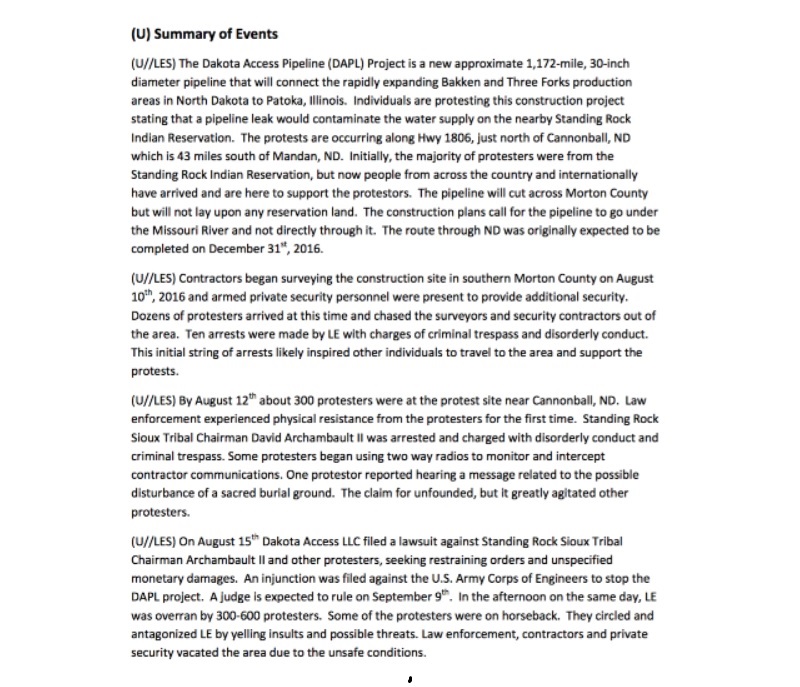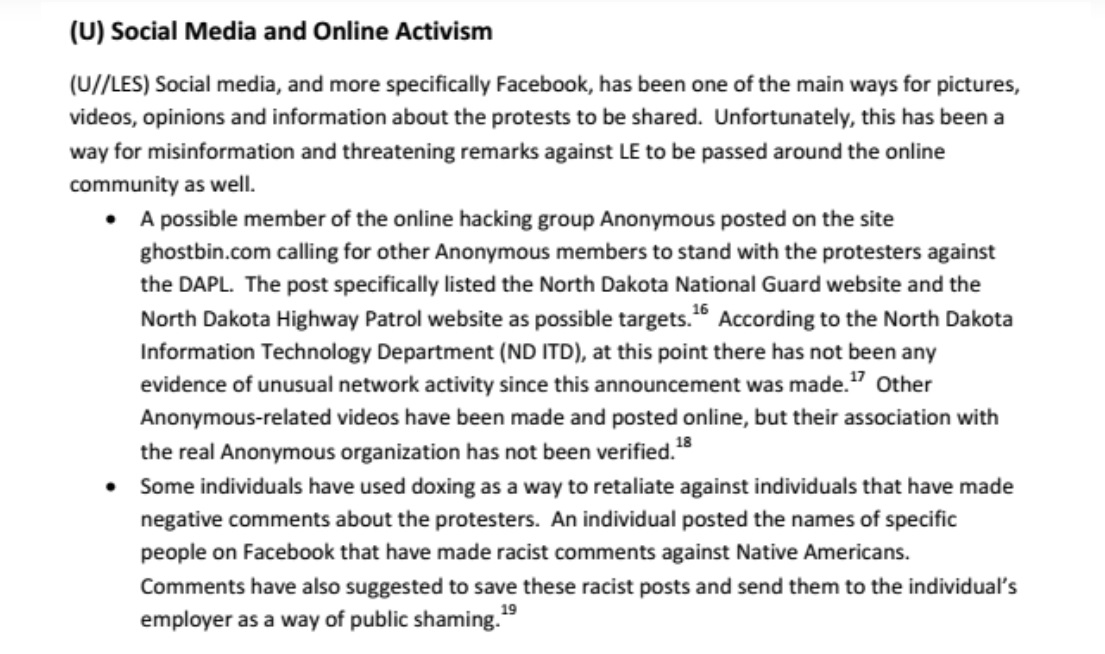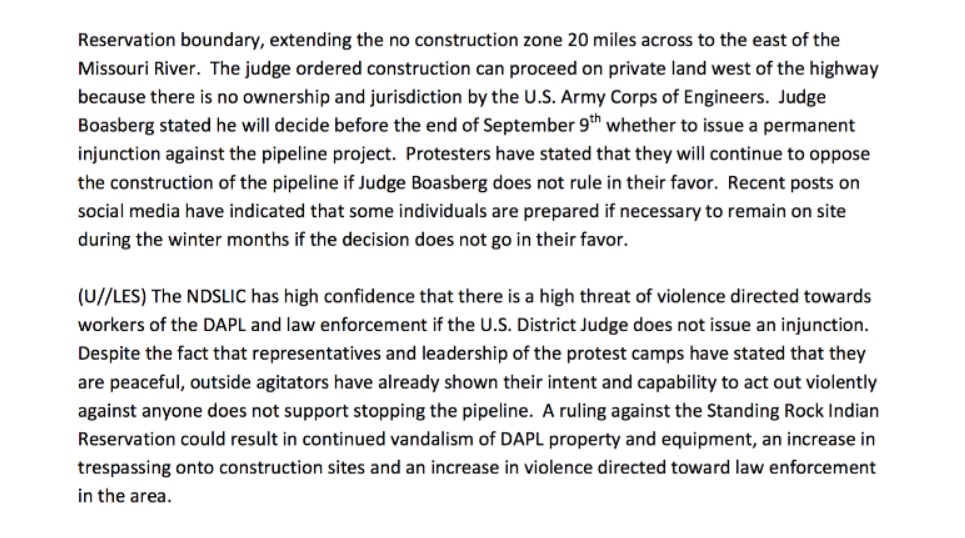MuckRock has uncovered a joint Morton County Sheriff’s Department and North Dakota State and Local Intelligence Center (NDSLIC, a fusion center) threat assessment, dated September 8th 2016, just as the protest near Standing Rock, North Dakota was beginning to crescendo. The 12 page document was part of the trove of records that MuckRock received from the Laramie County Sheriff’s Office in Wyoming.

The first portion of the report is a “summary of events,” most likely meant to provide a quick update to incoming law enforcement joining the effort to subdue the protest. The major issue that law enforcement seemed to be dwelling on was the fact that protectors had up until that point, been quite successful at stopping work on the Dakota Access pipeline (DAPL). This, obviously, was a major concern for law enforcement which was called in to suppress the protest and get the project underway again in order to meet the estimated date of completion, December 31st.

Law enforcement focused on protesters driving away oil workers, often claiming they had used force and threats to accomplish this. The threat assessment also makes note that sacred burial grounds were reported to have been disturbed, but at the time waved it off. Later, this would turn out to be true. It also appeared to law enforcement that the arrests were only bringing in more protesters, something that is unsurprising given the optics of unarmed, predominantly Indigenous water protectors facing armed police and private security.
On September 3rd, the assessment claims that that protesters trampled the fence separating pipeline employees and protectors with “dogs, horses, and vehicles,” and asserted that, “the pipeline security officers were hit and jabbed by the protesters with fence posts and flag poles.” The infamous dog attacks on protesters by DAPL private security that resulted are summarized simply as “Dogs were used for defense and protection for the workers.”

With equal succinctness, the report summarizes the controversy surrounding this with: “This event received a great deal of attention on social media. Individuals that are sympathetic to the protesters spoke out aggressively against the use of dogs for protection.”
The assessment also mentions a radio station called “Standing Rock Resistance Radio” that had advised its listeners to be “prepared to die for the cause.” When taking into account the force that had already been used against protectors, this seems more of a statement of the potential risks water protectors should be aware of.

Law enforcement surveillance of the protest has been fairly well documented, with near 24/7 North Dakota Highway Patrol aircraft flying over the campsites, protesters noticing odd things going on with their phones such as spurious Google login attempts, and the reams of police photos that have been released. The Intercept also reported in May on the infiltration and electronic surveillance used at Standing Rock through leaks they had received through TigerSwan of of the many private security firms brought in to handle the protest for Energy Transfer Partners (the energy company building DAPL). All this makes the next section of the threat assessment, “Surveillance Tactics Used Against LE (law enforcement) Personnel,” even more interesting.

Very little has been reported on this in the media, and it is very difficult to ascertain to the validity of these statements.
The next section covers “Social Media and Online Activism” - which warns of the threat of “doxing” against law enforcement and anti-protest commenters, particularity those on Facebook who had “made racist comments against Native Americans.”

Also of note here, is the bit about the online hacktivist collective known as Anonymous potentially targeting the North Dakota National Guard website (the North Dakota Information Technology Department had not actually noticed any abnormal activity on the targeted websites). This tip however, did come from a North Dakota law enforcement agency, like most of the others did. Instead, per the annotations at the end of the document, this tip came from the Michigan State Police, who did not respond to the EMAC (Emergency Management Assistance Compact) request, and had no other known involvement in the protest. It is unclear how they came about this information.
Fascinatingly, the report does not include one Indigenous, or even truly committed water protector, on the “Individuals of Interest” list. Instead, all were right-leaning white men like John Hildinger, a well known member of the 3% militia. Hildinger was removed from the protest after displaying a Confederate flag.

The “Groups of Interest” section is far meatier. Up first on the list was the journalist collective Unicorn Riot, which has long drawn the ire of law enforcement for filming police responses to protests. Or, as the threat assessment puts it, “UR is skilled at video recording police response to protestor [sic] action while “missing” the protestor [sic] action that caused it, to make the police response seem excessive.” Quite a claim.

Of the other ten groups listed, only two have had any kind of criminal record, and even then one that was decades old - the American Indian Movement, and the Nation of Islam, which the assessment reports as having a representative at the camps.

In the section on the September 9th Injunction Hearing, the report correctly anticipated that protesters would stay through the winter months if Judge Boasberg did not grant the injunction against DAPL (which he clearly did not). However, their assertion that NDSLIC had “high confidence that there is a high threat of violence directed towards workers of the DAPL and law enforcement if the U.S. District Judge does not issue an injunction,” did not pan out.

Also notable was the list of references which were used to create the document. As can be seen below, most of the references were intelligence tips to the Morton County Sheriff’s Department, MCSD intelligence, local North Dakota agencies such as Burleigh County Sheriff’s Office, Mandan Police Department, and the North Dakota Information Technology Department, with the exception of the Michigan State Police tip mentioned in the paragraphs above.

MuckRock has already filed for the rest of the threat assessments that were compiled along with these one, as the batch of Laramie County Sheriff emails alluded to this being just one of many intelligence updates created. We will update as soon as we receive the rest of the documents, in the meantime check out the rest of the threat assessment for yourself and see how law enforcement viewed developments during a crucial time in the protest movement.
Image via Emma Best




